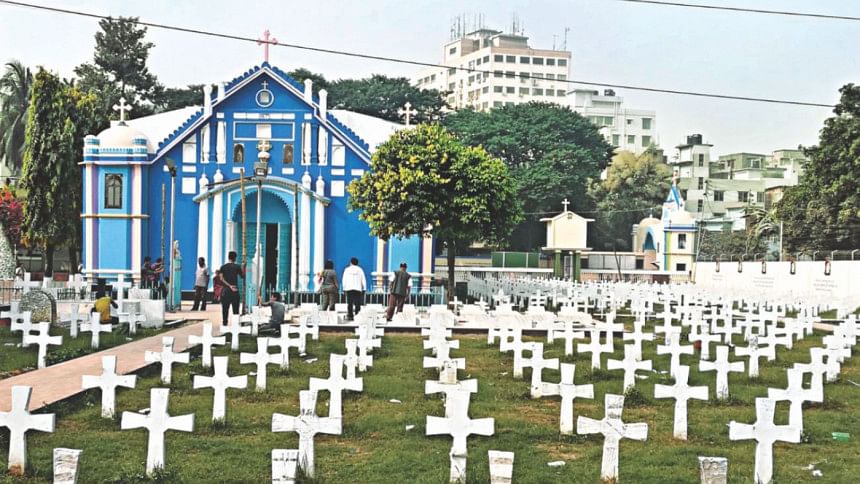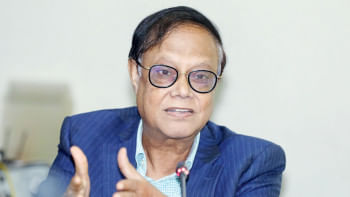The Portuguese in Dhaka

The Portuguese were not only the first Europeans to arrive in Bengal but to Dhaka as well. By that time, they were already infamous for their piracy and other adventures on coastal areas, the Sundarbans and along the big rivers. For example, from the descriptions of Fray Sebastien Manrique, a Portuguese missionary and traveller who visited Dhaka in 1640, there was a Magh raid in 1626 during which they (the Magh) had a few Portuguese working for their naval fleet. But the Portuguese in Dhaka are not be confused with the others who were engaged in piracy and pillaging together with the Maghs along the coast of Bengal, Swandip and Arakan (present day Myanmar). In Dhaka, the Portuguese were mostly missionaries and merchants coming primarily from their main base in Hugli.
According to the accounts of James Taylor (1840), who was the surgeon of Dhaka district, the oldest existing Portuguese structure today, the Holy Rosary Church in Tejgaon, was built in 1599 by Portuguese missionaries. He thought it was probably erected by merchants even earlier like other churches in the subcontinent. Actually, the church at Tejgaon was perhaps built a few years after 1599—some sources say, in the early seventeenth century. A H Dani, who was the reader in the Department of History in Dhaka University and curator of Dhaka museum in the 1950s, states that the present church was built much later, in 1677 (1679 according to S M Taifoor, Glimpses of Old Dhaka). There was, may be, a Portuguese settlement and a smaller church in the 1600s, as described by the Indian Civil Service officer B C Allen (1912) based on the travels of Ralph Fitch (a merchant from London and one of the earliest English travellers or traders to India and Southeast Asia) in 1586 and Francis Fernandez (the first Portuguese missionary in Bengal) in 1599. This was the first documented proof of encounter with the Portuguese in the vicinity of Dhaka. According to Campos, who wrote Portuguese in Bengal, (1919) they settled here in 1580.

Back then, the Portuguese were rebels against Emperor Akbar. In spite of that, they bought two villages in Bhowal, and most importantly bought a piece of land in present day Narinda. They definitely built a church in Narinda in the early seventeenth century. However, today, there is no trace of that church. But it was most probably situated at the site of the Christian Cemetery. This was the first church in Dhaka. The Portuguese officially established a mission in Dhaka in 1616, about 50 years before the viceroyalty of Shaista Khan (1664–1688).
In 1632, Emperor Shahjahan was outraged by human trafficking, unabated trade, heavy armament of their forts, and the power of the naval fleets of the Portuguese, and started to drive them out of Bengal (the siege of Hugli). The church in Narinda was abandoned during this period but was not damaged, as both Tavernier and Manucci (Jean-Baptiste Tavernier was a French gem merchant and traveller and Niccolao Manucci was an Italian writer and traveller, who worked in the Mughal court. Both of them visited Dhaka in the 1660s) found it in operation in the 1660–70s, when they came to the city. Actually the Portuguese had recovered very well through shifting their political allegiance to the Mughals. In his conquest of Chittagong from the Arakanese (1665–1666), Shaista Khan even received 40 ships from them for his naval fleet. In return he allowed a Portuguese settlement and trading post on the bank of Ichamoti river (about 25 km south of Dhaka) at the present day Muktarpur–Mirkadim area (Munshiganj), which still bears its historical name of "Firingibazar". The Portuguese were mainly involved in the salt trade.
Father Anthony Barbier in his visit to Dhaka in 1713 spent Christmas at the church in Narinda. But in 1789, the only church mentioned in documents was the one in Tejgaon, then a village four miles north of Dhaka's centre. Apparently, the church in Narinda had been deserted by this time and the activities had been shifted to Tejgaon. Nonetheless, the Portuguese settlers in Dhaka were still within proximity of the old church (present day Narinda-Laxmibazar area), as seen in the map of English geographer, historian and pioneer of oceanography Major James Rennell (1780), and identified by Dani. They had a factory there too—for trading purposes like other European trading communities—whose headquarters was there even in 1905, although in ruins by then, as described by Bradley-Birt (Francis Bradley Bradley-Birt, was an English member of the Indian Civil Service, who was stationed in Dhaka for a while and published The Romance of an Eastern Capital, his accounts of the city). Also depicted in the map is a Portuguese garden north of the Tejgaon church.
The Portuguese essentially paved the way for other European traders for doing business in Bengal. They were the first and as a result had to wrestle their way into Bengal, clashing not only with the Mughals, but also with Pathans and Arakanese. The two main reasons for their decline were: competition from other European trading powers, and the initial hostility between them and the Mughals. Other European powers started to receive firman (a grant or permit) for trading from the Mughals from the 1620s. Each European power wanted to create a monopolistic situation and the competition between them was toxic.
The siege and ransacking of Hugli in 1632 by the Mughals dealt a severe blow. After that, becoming an ally of the Mughals in 1665 proved to be fatal for the Portuguese, since the Mughals started losing power to the English in the eighteenth century. Moreover, when the Portuguese joined the Mughal army and naval forces, they had stopped raiding the coast of Bengal, and were even engaged in protecting their fellow countrymen from piracy and plunder. Most of them became merchants, and few became mercenaries. They were no longer a political or military force.

So after giving up their political entity and integrating as common men, they survived as tradesmen, even in eighteenth century Dhaka, as depicted in Rennell's map. But slowly, they lost their footing in business to others, first to the Dutch, then to the English, almost within a century (1665–1765). By the early eighteenth century they did not possess any real financial power to overthrow the Dutch of their trading supremacy in Bengal. It is unknown when the Portuguese factory was closed down in Dhaka, though their missionaries established another church in Dhaka district in 1815. These churches, the names of some places where they settled and the epitaphs in the cemeteries are the last traces of the Portuguese in Dhaka.
Dhrubo Alam is a research associate at the Bengal Institute.





Comments